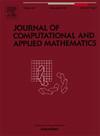Hybrid flux reconstruction schemes with weighted correction functions
IF 2.6
2区 数学
Q1 MATHEMATICS, APPLIED
Journal of Computational and Applied Mathematics
Pub Date : 2025-09-10
DOI:10.1016/j.cam.2025.117046
引用次数: 0
Abstract
This paper proposes a novel approach to developing hybrid flux reconstruction (HFR) schemes through weighted correction functions. The methodology synthesizes correction functions via linear combinations of existing formulations, leading to enhanced numerical properties. The proposed framework is demonstrated by constructing hybrid schemes based on correction functions from the discontinuous Galerkin (DG), spectral difference (SD), and staggered-grid (SG) schemes, representing three well-established classes of FR schemes. Theoretical investigation through von Neumann analysis reveals the influence of weighting parameters on the dissipation and dispersion characteristics. Numerical experiments with the linear advection equation, linearized Euler equations and nonlinear Euler equations demonstrate that optimally weighted correction functions can achieve superior accuracy and stability compared to their constituent base schemes. Specifically, the optimal weighting coefficient in the HFR1 scheme enables it to achieve even higher accuracy than the DG scheme, whereas the optimal weighting coefficient in the HFR2 scheme yields a CFL limit exceeding that of the SG scheme. From a practical perspective, this work provides a straightforward approach for generating a wide range of FR schemes with predictable numerical characteristics.
带加权校正函数的混合通量重建方案
本文提出了一种利用加权修正函数开发混合通量重建方案的新方法。该方法通过现有公式的线性组合来综合校正函数,从而增强了数值性质。通过构造基于不连续伽辽金(DG)、谱差(SD)和交错网格(SG)格式的校正函数的混合格式来证明所提出的框架,代表了三种成熟的FR格式。通过冯诺依曼分析的理论研究揭示了加权参数对耗散和色散特性的影响。对线性平流方程、线性化欧拉方程和非线性欧拉方程的数值实验表明,最优加权修正函数比其组成基格式具有更高的精度和稳定性。具体而言,HFR1方案的最优加权系数使其比DG方案获得更高的精度,而HFR2方案的最优加权系数使其CFL极限超过SG方案。从实际的角度来看,这项工作为产生具有可预测数值特征的广泛FR方案提供了一种直接的方法。
本文章由计算机程序翻译,如有差异,请以英文原文为准。
求助全文
约1分钟内获得全文
求助全文
来源期刊
CiteScore
5.40
自引率
4.20%
发文量
437
审稿时长
3.0 months
期刊介绍:
The Journal of Computational and Applied Mathematics publishes original papers of high scientific value in all areas of computational and applied mathematics. The main interest of the Journal is in papers that describe and analyze new computational techniques for solving scientific or engineering problems. Also the improved analysis, including the effectiveness and applicability, of existing methods and algorithms is of importance. The computational efficiency (e.g. the convergence, stability, accuracy, ...) should be proved and illustrated by nontrivial numerical examples. Papers describing only variants of existing methods, without adding significant new computational properties are not of interest.
The audience consists of: applied mathematicians, numerical analysts, computational scientists and engineers.

 求助内容:
求助内容: 应助结果提醒方式:
应助结果提醒方式:


